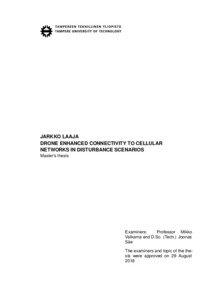Drone Enhanced Connectivity to Cellular Networks in Disturbance Scenarios
Laaja, Jarkko (2018)
Laaja, Jarkko
2018
Tietotekniikka
Tieto- ja sähkötekniikan tiedekunta - Faculty of Computing and Electrical Engineering
This publication is copyrighted. You may download, display and print it for Your own personal use. Commercial use is prohibited.
Hyväksymispäivämäärä
2018-11-07
Julkaisun pysyvä osoite on
https://urn.fi/URN:NBN:fi:tty-201810242461
https://urn.fi/URN:NBN:fi:tty-201810242461
Tiivistelmä
Power outages caused by intense storms require a vast repair operation to restore power. During these disturbance scenarios, repair workers need a cellular connection in order to fulfill their work assignments. However, the cellular network base stations that provide coverage to the repair area might be effected by the blackout. The reserve batteries on these base stations last only a couple of hours. To solve this lack of cellular connectivity, repair crews have to drive several kilometres searching for a working connection. This delays the repair process a great deal.
This thesis examines using a drone to solve this connectivity problem. Even though there is no working connection at the ground level, a functioning communication link could be achieved above the tree tops, where there is less signal attenuation from trees and hills. With increased altitude, the drone should be able to achieve a line-of-sight connection to farther away base stations that are still in working order. These better signal propagation conditions were the premise of this study. The proposed solution is to attach a cell phone to the drone and share the phone’s cellular connection as a Wi-Fi hotspot to the repair crew on the ground.
To analyse the feasibility of such a solution, a measurement campaign was performed in rural areas in the Pirkanmaa region. The phone attached to the drone measured cellular network parameters, such as signal strength and signal quality. The primary objective was to research the effect of altitude on these performance parameters. Additionally, another area of focus was to study the cell phone’s connection to distant base stations that are not available at the ground level. For that reason, the drone flew predetermined, autonomous flight routes around the measurement sites at altitudes of 50 m, 100 m, and 150 m. During these flight paths, the phone measured the performance of 2G GSM, 3G UMTS, and 4G LTE networks.
The results indicate that signal strength increases considerably with increased altitude. In the air, the phone has a 20–30 dB stronger received signal power compared to the ground level. However, at the same time, signal quality decreases, as the phone suffers interference from other base stations. Furthermore, this improvement of signal power results in an increase of signal range. The phone was able to connect to base stations tens of kilometres away from the measurement site. This increased signal range means that the repair team is able to get a working cellular connection from the repair site without having to look for a signal. Using a drone as a temporary access point is a viable solution in disturbance scenarios and warrants further research on this topic.
This thesis examines using a drone to solve this connectivity problem. Even though there is no working connection at the ground level, a functioning communication link could be achieved above the tree tops, where there is less signal attenuation from trees and hills. With increased altitude, the drone should be able to achieve a line-of-sight connection to farther away base stations that are still in working order. These better signal propagation conditions were the premise of this study. The proposed solution is to attach a cell phone to the drone and share the phone’s cellular connection as a Wi-Fi hotspot to the repair crew on the ground.
To analyse the feasibility of such a solution, a measurement campaign was performed in rural areas in the Pirkanmaa region. The phone attached to the drone measured cellular network parameters, such as signal strength and signal quality. The primary objective was to research the effect of altitude on these performance parameters. Additionally, another area of focus was to study the cell phone’s connection to distant base stations that are not available at the ground level. For that reason, the drone flew predetermined, autonomous flight routes around the measurement sites at altitudes of 50 m, 100 m, and 150 m. During these flight paths, the phone measured the performance of 2G GSM, 3G UMTS, and 4G LTE networks.
The results indicate that signal strength increases considerably with increased altitude. In the air, the phone has a 20–30 dB stronger received signal power compared to the ground level. However, at the same time, signal quality decreases, as the phone suffers interference from other base stations. Furthermore, this improvement of signal power results in an increase of signal range. The phone was able to connect to base stations tens of kilometres away from the measurement site. This increased signal range means that the repair team is able to get a working cellular connection from the repair site without having to look for a signal. Using a drone as a temporary access point is a viable solution in disturbance scenarios and warrants further research on this topic.
